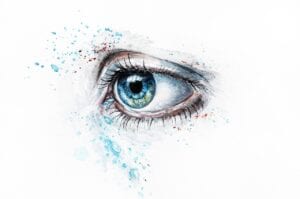Wet Macular Degeneration
What is wet macular degeneration?
Wet macular degeneration (wMD) is one of two forms of macular degeneration, and it is characterized by blurred vision or blind spots in one’s vision. The wet form is more rare than the dry form, but wMD always begins as dry macular degeneration.
What are the symptoms of wet macular degeneration?
The onset of symptoms in this condition is sudden, and symptoms tend to progress quickly. Possible effects include:
- A hard time recognizing faces
- Visual distortions
- Trouble adjusting to low light
- Needing brighter light for activities like reading
- Reduced central vision
- Trouble reading due to the blurriness of printed words
- Colors seem less bright and intense
- Blurry spot within the field of vision
What causes wet macular degeneration?
Only 20% of macular degeneration patients have the wet form, and doctors are unsure as to why it develops from dry MD. There are two possible ways that this process occurs. The first way sees abnormal blood vessels grow out from under the choroid and into the macula, where they leak blood and fluid. This leads to vision loss. The other method occurs when fluid leaks from the choroid and accumulates, leading to the symptoms of wMD.
Possible risk factors include obesity, cardiovascular disease, being of Caucasion descent, a family history of wet macular degeneration, smoking, and being above age 55.
How is wet macular degeneration diagnosed?
The first step in diagnosis is a review of a patient’s medical and family history. This is followed by an eye exam, an evaluation of the back of the eye, indocyanine green angiography, optical coherence tomography, tests to find defects with central vision, fluorescein angiography, and optical coherence tomography (OCT) angiography.
What are the treatments for wet macular degeneration?
If the correct diagnosis is given quickly enough, it is possible to stop and even reverse disease progression, therefore preserving or regaining one’s vision. Medications that may be prescribed include Eylea, Avastin, Beovu, and Lucentis, all of which stop the body from growing more blood vessels in the eyes. Other treatment options include photodynamic therapy, low vision rehabilitation, and photocoagulation.
Where can I find out more about wet macular degeneration?
Wet Macular Degeneration Articles

Rare Community Profiles: Wet Age-Related Macular Degeneration: Treatments Continue to Improve


Vabysmo Shows Advantages Over Aflibercept in Wet AMD and Diabetic Macular Edema

Study: One Wet Age-Related Macular Degeneration Drug Appears Superior to the Other

Clinical Trial Results Show Wet Age-Related Macular Degeneration Patients May Need Less Frequent Treatment


Georgia Retina Performs First Susvimo Implantation in State for Wet Macular Degeneration







